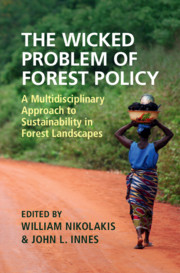 The Wicked Problem of Forest Policy
The Wicked Problem of Forest Policy Book contents
- The Wicked Problem of Forest Policy
- The Wicked Problem of Forest Policy
- Copyright page
- Contents
- Contributors
- 1 The Wicked Problem of Forest Policy
- Part I Wicked Problems and Policies
- 2 Why Forests Matter?
- 3 Forest Certification and Forest Use
- 4 REDD+ Meets Local Realities
- 5 Have Payments for Ecosystem Services Delivered for the Rural Poor?
- 6 Tackling Gender Inequality through Forest-Related Policies and Programmes
- 7 Forestry Crimes and Our Planet
- 8 Forest Bioeconomy Development
- Part II Tools to Address Wicked Problems
- Index
- References
2 - Why Forests Matter?
from Part I - Wicked Problems and Policies
Published online by Cambridge University Press: 24 July 2020
- The Wicked Problem of Forest Policy
- The Wicked Problem of Forest Policy
- Copyright page
- Contents
- Contributors
- 1 The Wicked Problem of Forest Policy
- Part I Wicked Problems and Policies
- 2 Why Forests Matter?
- 3 Forest Certification and Forest Use
- 4 REDD+ Meets Local Realities
- 5 Have Payments for Ecosystem Services Delivered for the Rural Poor?
- 6 Tackling Gender Inequality through Forest-Related Policies and Programmes
- 7 Forestry Crimes and Our Planet
- 8 Forest Bioeconomy Development
- Part II Tools to Address Wicked Problems
- Index
- References
Summary
Forest policy is a wicked problem precisely because forests matter to so many different people for so many different reasons. Developing institutions to mediate among the various claimants to forest land, buyers and sellers of forest goods, and beneficiaries of forest services has proven challenging to local user groups and international negotiators alike. This chapter focuses on tropical forests, which have a disproportionately significant value for global biodiversity conservation and climate stability, as well as contributing to the livelihoods of some of the world’s poorest people. However, tropical forests are disappearing at alarming rates. There are no simple solutions to solving wicked forest policy problems, but community forestry, improved governance, changing norms, new forms of finance and technology, such as advances in remote sensing technology, are crucial to sustainably managing forests.
- Type
- Chapter
- Information
- The Wicked Problem of Forest PolicyA Multidisciplinary Approach to Sustainability in Forest Landscapes, pp. 33 - 58Publisher: Cambridge University PressPrint publication year: 2020
